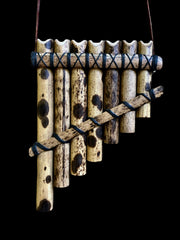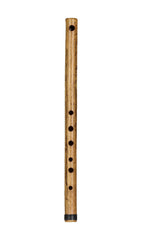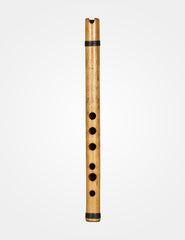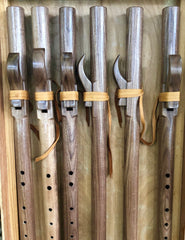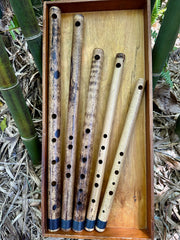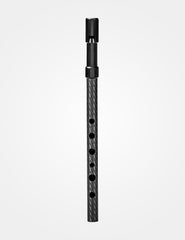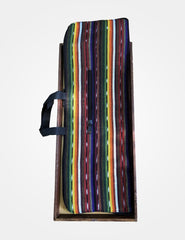Dearest Bamboo VIP:
You are invited to an exclusive lunch and Round Table to discuss the Japanese plant Taiho Chiku known in 1886 as Bambusa Argentea Striata in Florida. All my special guests have not only touched the world with their plant endeavors but you are responsible for birthing my world wide flute career. It will be my great honor to have you arrive at 10 AM Saturday July 11th, and enjoy the warm fellowship of many of your colleagues. Please be prepared to share the story of your contribution with this plant.
Sincerely and with great gratitude,
Erik The Flutemaker
Four months later at 9:57 am, they began to arrive.


Mr. Hart arrived with his wife Isabella and 3 daughters in an old wooden wagon from north Florida. I recognized him immediately. "Oh my, Edmond Hall Hart! Welcome! You were the first to announce our flute making bamboo in the newspapers on July 19th 1886.” I shook his hand wildly. “ Mr. Hart, today I will ask you what I have been dreaming to ask you, how did you obtain this plant from Japan that changed and defined my life?”
Hart took a breath and said, "Erik the flutemaker, what a splendid day this is, I have heard you have been following my work for 8 years and have some of my pictures from the 1884 World’s Fair in New Orleans and have been to my place in Federal Point. A joy to finally meet you. Yes, I can help you with that answer. Because in 1883 I had been looking for hardy bamboos that would not die under our occasional freezes in Northern Florida.”
Hart came to Florida 2 years after the Civil War with his father and 2 of his brothers who served in the Union Army. Florida was a total wilderness where they settled and was only available by boat on the St. Johns River. Hart found wild orange trees that originally grew when Ponce De Leon’s Spaniards spat out orange seeds from the oranges they brought with them from Puerto Rico, that had come from Spain. As the Spaniards moved up the Indian trails of Florida, in search for gold for the King of Spain and for the Fountain of Youth, eating oranges, those orange seeds grew orange trees and that fruit was picked by the Florida natives and taken to their hunting grounds where they were eaten and in turn spat out, creating clusters of wild stock orange trees. Hart cut off the tops of those trees and dug up the roots with the trunks and took them home and grafted good orange branches into them. He was a plant genius growing over 150 citrus plants and many tropicals from around the world and became responsible for one-third of today's orange business in Florida.
Hart stepped off the wagon and said, “Come girls, I present you to Erik the Flutemaker. Remember the bamboo at home? Our workers use the poles to fish from our dock. Erik, is famous for making flutes from it and has sent them out all around the world." Then Hart’s daughter Francis asked, " "Will you be playing for us today?
"Well Francis, I hadn't thought of that. But what a great idea.”
Come children, said Isabella, "I see another carriage is arriving."
I pointed the way and said, “Please come this way through my Japanese garden to the back, to enjoy our bamboo grove as the other guests arrive.”
The Hart's were driven down by Mr. Theodore Williams known in Federal Point as Shepherd, a former enslaved Afro American and Civil War veteran of the Black 54th Massachusetts Regiment. Shepherd was like a pastor to the Afro-American community there, and told the story when Col. Shaw led them into battle. “Col. Shaw led the Black Union Troops July 18th 1863, against Fort Wagner, South Carolina. I was 18 then, and as we approached the walls of the fort the brave Col. riding his black horse was fatally wounded, I was by his side when he was shot. His foot hit me when I tried to catch him when he fell."
I reached out to shake the driver’s hand and said, “Mr. Williams it is, nice to meet you! Please come in and join us. As Shepherd moved his wagon, Theodore Luqueer Mead and his wife and daughter pulled up.

“Mr. Mead, what an honor sir to meet you and your family. Mam.”, I bowed my head. And took her hand to help her off the carriage. “Mr. Mead, you were the first to plant Bambusa Multiplex Alphonce Karr in Florida! We have it growing all over our acre. I know you ordered it in 1887 from H. H. Berger & Co. Please share with us later how you connected with Mrs. Berger. Was it simply due to her advertising in the Florida papers that year that she was selling Bambusa Nana? Or was it a tip thought Hart? And did you encourage Henry Nehrling to order from her in 1895? And did you put the Reasoner's in touch with her too? And who was the German and English speaking company that you first bought bamboo from in 1884? I understand you and Hart met in 1883 by letters, I have read them. Oh, I have so many questions for you!
You know we both have some things in common. We both left New York City as a 17 year old and went to Colorado and then onto California, and we both settled in Florida and planted bamboo. And we were both born in 52. You in 1852 and I in 1952. Please enjoy your friend Hart as the others arrive.

Coming down the road was Henry Nehrling in a 1908 Model T Ford. "Hello Mr. Nehrling! Welcome! Your old friends Hart and Mead have arrived. You know I have harvested your flute making bamboo from your historical garden three times! And made many flutes from there. Welcome! Today I would love for you to share if it came through Mrs. Berger who was selling it in 1895 when you ordered it from Japan.

Also Mr. Nehrling, I noticed you planted some in Thomas Edison’s garden too. I got to see his clumps down by the river. Lots of coral there, so it is quite stunted. Thank you for coming!”
As a boy during the Civil War, Henry Nehrling walked through a first growth forest in Wisconsin to get to school. He would stop to see the birds and plants and later wrote books on both subjects. He bought land near Orlando in 1884 and created a famous garden that thousands came to see including Teddy Roosevelt, David Fairchild the world wide plant collector, Thomas Edison, Firestone and Henry Ford.

Behind Henry Nehrling came The Reasoner Brothers, Egbert and his older brother Pliny. They were one of the first to start a tropical nursery in Florida. After visiting Hart’s Garden in 1887 I believe Pliny was gifted a cutting from the original bamboo plant from Hart, as Pliny mentioned he had the plant in his 1887 catalog with a description by Hart. The bamboo mentioned above it, and below it from India, had a price but not his new Bambusa Argentea Striata because I believe it was not ready to sell. And I recall the first time I stumbled onto that very clump decades ago, the owner said it was a historical clump.
“Hello Pliny, Good day Egbert, you guys really moved a lot of Bambusa Argentea Striata around Florida. I stumbled onto your original clump and then found it again around 30 years later while on my historical bamboo search. And even made some flutes from it. But for years I wanted to know was your plant originally a gift from Hart? Today I will find out. Welcome! Many of your friends are here. I also know you used Mrs. Berger as a source for Japanese plants. So perhaps you got some bamboo from her?
It was sad to learn that Pliny at 25 after returning from a horticultural show in Cincinnati came home to help those in his town of Bradenton Florida who were struck by Yellow Fever. During his selfless act of love to help, he caught it himself and died. He was already a published authority and was known around the world. It was nice to see him in my mind as I lay on my bed receiving the heroes of the Bamboo story of how your flute bamboo may have gotten here, before falling asleep.

As the Reasoners began to mingle with the guests, David Fairchild pulled up in his 1932 Plymouth. Hello sir, Welcome! Thanks for coming.”
Fairchild opened his car door, his windows were down as he had no Ac in the car. “Well, for me it was easy, as I have moved to Coconut Grove."
"Yes! I said, “I have been to your house and seen many of the bamboo clumps there. I understand you sent our flute-making bamboo to the USA from the Yokohama Nursery in Japan first in 1902 and in 1908 and 1916.”
Fairchild was the head of the US Department of Agriculture International plant collections. That bamboo settled in Homestead. Florida where I found it in 1975 on the land of an Agricultural agent and used it from 1975 to 1995. I understand you got it from Mr. Suzuki. He too, will be here soon! Welcome!"
Fairchild was born in 1869 his uncle was an abolitionist and he married the daughter of Alexander Bell the inventor of the telephone. David Fairchild traveled the world bringing plants to the US and sending out botanical agents to do the same. Fairchild wrote in 1905, “ With the bamboos, we need a pied piper who can plant it and live with it to see how best to grow it and see what he can do with it.” I felt he was talking to me.

I couldn't believe my eyes when a stagecoach came into sight coming down my block. Many of my neighbors had come out of their houses and were watching the parade of those coming for the historical visit.
The horses were sweaty and tired and the wood doors flew open and out came a stiff General Capron, the oldest Union general of the Civil War, who as a boy met General Lafayette who served with George Washington. After the War, his friend General Grant became President and asked him to lead up the new US Agricultural Department, as Capron was a clever farmer. He wanted to help the South rebuild after the war. But suddenly one day his life shifted again as he was asked by an agent of the Japanese government to come and help establish agriculture and import farm animals to transform the Island of Hokkaido in north Japan into an Agricultural system. The Samurai had been defeated and the country was embracing the modern world. President Grant accepted his resignation and gave him his blessing. The Japanese had offered Capron $10,000 in gold to go. He took the money and went.
But first General Capron asked his friend Louis Bohmer who was running his own Nursery in Rochester NY to join him. What a thrill to see Louis Bohmer, a German horticulturalist who once was the head gardener of the royal garden in Hanover, Germany, step out from the stagecoach behind General Capron.

"Mr. Bohemer, oh my! Because you went to Japan to help General Capron and later started your own nursery in 1882 in Yokohama, and sold Taiho Chiku, I became a flutemaker! Your manager and plant collector Uhei Suzuki who had lived in the south of Japan where our bamboo had settled in from China, must have brought it to your nursery. I know it traveled by the Mail steamer to San Francisco and then by train to Florida.” A funny smile came over Bohemer’s face as he stepped down.

Then suddenly my breath was almost stolen away when Suzuki popped his head out from the coach and dismounted and bowed. I did too and said. "Oh sir, you are responsible for my flute career! We held our hands together smiling and bowing about 3 times. Please join our guests. Thank you for coming.” As General Capron walked stiffly, I could see his old age. He was the founder of Laurel Maryland where a cousin of mine later would be the mayor. After his return from Japan he went to celebrate the inauguration of the Washington Monument February 21st. It was a freezing 12 degrees outside and a wet day in 1885. General Capron was now 80 and he suffered a stroke and passed the next day. But it was General Capron who got the ball rolling to get Boehmer to Japan to connect with Suzuki and bring me my bamboo.


Another old stagecoach was coming down. My neighbors were now walking towards my bamboo grove to see what was going on. The stagecoach doors opened and to my surprise I was almost swept off my feet to see Henry Berger, creator of H. H. Berger & Company. Henry was born in 1854, and Helen Berger was born in 1850 and Emily, Hellen's daughter was born in 1869. They all dismounted the stagecoach. They were the first to bring Japanese plants to the USA in mass.
“Henry! Helen! What an absolute honor to finally meet you. You too Emily! I feel we are already friends. Thank you for coming. You are my, so honored guests. Henry, because you went to Japan in 1875 to teach German and connected with Louis Boehmer and began sending plants to San Francisco in 1877, I have a career in flute making. Helen, thank you for advertising that you were selling bamboo in the Florida papers. Some of your buyers are here, Mead and Nehrling and today you can share the mystery, if it was you who sold Hart his bamboo in 1885 that started it growing in Florida. I realized I was still squeezing their hands as we spoke. They moved into the garden area to join the others and I could hear the buzz grow louder as they were recognized by the other guests.

I turned my eyes down the street and saw a farm wagon. It was George Taber the owner of the Glen Saint Mary Nurseries, 33 miles west of Jacksonville Florida. Sir, I can't believe you made it! Thanks for coming! I have harvested your Bambusa Argentea Striata twice from your farm. On your old carriage road that joined Jacksonville and Tallahassee in the 1850’s. When you started your nursery in 1884 I imagine you had no idea you would have such a large area growing bamboo. And no idea that the Bamboo planted by the Department of Agriculture at your place in 1908 would be great flute material and that flutes from your place would be sent out all around the world! I met your great grandson and his wife who were a tremendous blessing of kindness and grace. I also learned that after Mr. Hart had passed in 1898 that you came to Federal Point and bought up many of his plants to help support his family. Was one of those plants his Bambusa Argentea Striata? I saw in a 1920's photo a big clump growing behind your office. We will chat later. There is Hart over there entertaining the guests with his funny stories. So many of my guests know you from the Horticultural meetings in Florida in 1887. Thank you for coming. Please join your friends in the garden. I will join you shortly as most of my guests have arrived and I see a carriage approaching.



It was Floyd Alonzo McClure! Who went to China in 1919 and became the Bamboo Ambassador from the East to the West. Many of the bamboos he sent grow at my place. Textillis Gracilis, Gracilis, Mutabilis and Bambusa Multiplex. He served at the Canton Christian College where he planted a bamboo garden with 600 different plants from all over. While in China, McClure's area was taken over by a Japanese invasion. His Japanese guard one day said, “ I used to be a teacher, and would like to know more about bamboo.” McClure tuned to the Chinese cook and said. “He wants to know more about bamboo! Prepare him a place at the table tonight for dinner!” Later McClure set up a bamboo garden in Puerto Rico and from there, many tropical bamboo gardens throughout Central and South America were established. I found the one in Nicaragua and made a flute from the Bambusa Multiplex there.
Hello Mr. McClure, what a joy to meet you! I read that you visited Nehrling’s garden when Julian Nally owned the place. (Julian was the son of the President of RCA - Radio Corporation of America). I made many flutes from that Silverstripe. And I also found your lost bamboo plantation in the Miskito Coast in Nicaragua! I was surprised to find out that you too had made and played a flute. Please come in and meet the very early bamboo enthusiasts.

Then Charles Simpson pulled up in a wagon, Simpson served with Union General Sherman in the campaign from Atlanta to the Sea. He later worked for the Reasoner Brothers as a carpenter making nursery green houses and going on collecting expeditions with Pliny through South Florida. Charles was part of a posse with Pliny when some southern cowboys killed the northern born Postman. Simpson became a renowned horticulturist and author.

The cool story I liked, was when he visited Henry Nehrling, and during the night behind the above bedroom window, Charlie Simpson was captivated by the bamboo moving in the breeze in the moonlight and worshiped for hours. I had the joy of standing in the same room and looked out of that old thick window glass and that bamboo over 123 years later, is still there. And the cool thing also for me was, it was a Berger bamboo sent to Nehrling in 1895 from Japan.
Mr. Simpson, thanks for coming! Your friends Pliny, Egbert and Fairchild are already here.
Let me join you as I believe this concludes our guest list. And we can get the meeting started. By the way, I love that story you told, when after days lost in the everglades collecting plants, you finally came out caked in mud and emaciated and dying of thirst when you stumbled up to a house and asked for water. And the owner with his rifle held you at bay thinking you were a mad man and would not give you any. And how you convinced him by showing him a $20 gold piece. Saying, “Would a mad man be carrying such funding, I am not a mad man, I am a lost botanist!”
Approaching the group I raised my voice and said, "Gentlemen, Ladies, let us gather inside for our lunch. You have no idea how thrilled I am to have you all here, to see my bamboo garden and flute shop. And Francis, Hart's daughter piped up, “And to toot for us!” And all laughed. Continuing, I said, “And to finally know the mystery of how it arrived to you, Mr. Hart, with that consignment of orange trees from Japan.
Today I recall the words of Henry Nehrling, when you said,” "Bamboos! What a world of beauty and elegance and grace..."
And in the words of Helen Berger "A group of bamboos is one of the most graceful sights in nature, eminently useful and valuable in Florida from our nurseries in Yokohama." You were both so right!
Welcome! Please come inside, wash up from the trip, we will have lunch and then the Round Table shall begin. Shepherd please tell all the drivers to come and eat too. I will get some buckets of water so the horses may drink.”
After lunch, we cleared the table and I raised my voice, “Well, Mr. Hart please tell us all how did Taiho Chiku of the Japanese bamboo known in Florida by you as Bambusa Argentea Striata and later by the plant community as Bambusa Multiplex Silverstripe, fall into your hands?”
Hart stood up and slowly looked across the room and said, “I have totally forgotten.” There was a roar of laughter. I almost fainted. Many of those there had moved millions of trees, plants, seeds and bulbs and were getting old. Hart was born in 1839 and had a great sence of humor. His funny poems were published in the local papers in Palatka. And his plant articles in the horticultural magazines in the USA and Canada carried his funny remarks too.
When the room settled down, Edmund Hall Hart said, "Here is a clue, Erik. Mrs. Berger was calling one of her bamboos Bambusa Nana. Which according to Fairchild is Bambusa Multiplex which is what Bambusa Argentea Striata is. But she was not calling it by the name I was calling it. It was the German botanist Regel who became Russia’s curator of the St. Petersburg Royal gardens that gave it the name, Bambusa Argentea Striata. In 1865 he sent some to England. I have bought plants from the German Nursery Hagge and Schmidt who was a customer of Louis Bohmer, who got it from Suzuki. If all is correct it was through them that the bamboo came to me with a consignment of oranges directly from Japan. There was silence in the room.

Or was it through John Rock, a customer of Berger? And again the room burst out in laughter and I again almost passed out. Hart went on. John and I were award winning competitors in the 1884 New Orleans Worlds’ Fair. And when we spoke he mentioned the Bergers having sold him bamboo. There was a pause.

Or did I get it from Kizo Tamari? Laughter again bounced off the walls in our dinning room. “He was at that fair with 25 varieties of bamboo from Japan. It may have been from him, as I may have asked him to send me whatever he could after the show. But it needed to withstand our cold snaps. As I told Mr. Mead back in 1883, that I needed to find the right bamboos for our area.”
By this time my breathing had deepened and I was drifting off into a deep sleep and my thoughts were no longer mine.
John Rock… hummmm, served in the Union Army, was on Lincon’s funeral procession, started a giant nursery in California, was a customer of Berger, sold bamboo from Japan, must have met Hart at New Orleans… but those 25 bamboos from Kizo Tamari … that could have been it…that could have been… that could have… that…zzz…

For ten years I have been following leads to get the story of how my flute making bamboo came to Florida. Erik the Flutemaker
Thanks to Rollins College in Winter Park Florida and other internet photos that have helped to share this story.
